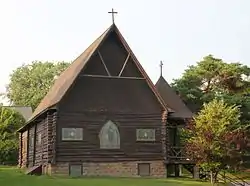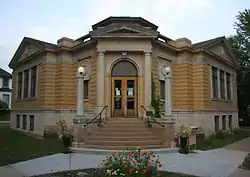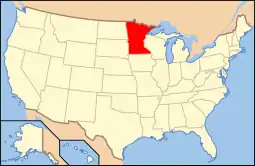National Register of Historic Places listings in Itasca County, Minnesota
This is a list of the National Register of Historic Places listings in Itasca County, Minnesota. It is intended to be a complete list of the properties and districts on the National Register of Historic Places in Itasca County, Minnesota, United States. The locations of National Register properties and districts for which the latitude and longitude coordinates are included below, may be seen in an online map.

Location of Itasca County in Minnesota
There are 20 properties and districts listed on the National Register in the county. A supplementary list includes one additional site that was formerly listed on the National Register.
- This National Park Service list is complete through NPS recent listings posted January 29, 2021.[1]
Current listings
| [2] | Name on the Register | Image | Date listed[3] | Location | City or town | Description |
|---|---|---|---|---|---|---|
| 1 | Bigfork Village Hall |  Bigfork Village Hall |
October 17, 2012 (#12000871) |
200 Main Ave. 47°44′38″N 93°39′17″W |
Bigfork | Fieldstone municipal hall built in 1936 with Works Progress Administration funds to provide a much-needed government and community center.[4] |
| 2 | Bovey Village Hall |  Bovey Village Hall |
August 15, 1991 (#91001059) |
402 2nd St. 47°17′43″N 93°24′58″W |
Bovey | Well-preserved example of a municipal hall built with federal assistance during the Great Depression, constructed 1934–5. Further noted as one of Minnesota's first Public Works Administration projects and for its eclectic period revival architecture.[5] |
| 3 | Canisteo District General Office Building |  Canisteo District General Office Building |
April 22, 1982 (#82002970) |
200 Cole Ave. 47°17′11″N 93°25′26″W |
Coleraine | 1908 brick office building, representative of mining company towns throughout the Mesabi Range.[6] Demolished in the summer of 2013 by the City of Coleraine and the Greenway School District. |
| 4 | Central School |  Central School |
August 16, 1977 (#77000746) |
N. Pokegama and 4th St. 47°14′11″N 93°31′45″W |
Grand Rapids | Landmark Richardsonian Romanesque school in use for 77 years, one of the first high schools in northern Minnesota outside of Duluth upon its completion in 1895, and one of the only intact 19th-century buildings remaining in Grand Rapids.[7] |
| 5 | Church of the Good Shepherd |  Church of the Good Shepherd |
August 11, 1980 (#80002081) |
Off U.S. Route 169 47°17′14″N 93°25′46″W |
Coleraine | Finely crafted log church built in 1908 by U.S. Steel as a religious and social center for its managerial class, reflecting the strict social hierarchy maintained by the mining companies and the lavish support for those in the upper ranks.[8] |
| 6 | Coleraine Carnegie Library |  Coleraine Carnegie Library |
July 17, 1980 (#80002080) |
Clemson and Cole Aves., S. 47°17′14″N 93°25′28″W |
Coleraine | Carnegie library built in Neoclassical style in 1912 to educate and acculturate immigrant mine workers and their families, emblematic of the corporate paternalism of the region's iron mining companies.[9] |
| 7 | Coleraine City Hall |  Coleraine City Hall |
June 18, 1992 (#92000800) |
302 Roosevelt Ave. 47°17′19″N 93°25′30″W |
Coleraine | Renaissance Revival municipal hall built in 1910 to house Coleraine's government offices, fire department, jail, and auditorium as the community evolved from a mining company town to an incorporated village.[10] |
| 8 | Coleraine Methodist Episcopal Church |  Coleraine Methodist Episcopal Church |
April 22, 1982 (#82002971) |
NW. Gayley and Cole Aves. 47°17′14″N 93°25′41″W |
Coleraine | Largest church on the western Mesabi Range, built 1908–9 with a lower-level YMCA. Significant as a major example of Shingle style architecture in northern Minnesota and a key element of the planned community of Coleraine.[11] |
| 9 | General Superintendent's House |  General Superintendent's House |
April 22, 1982 (#82002972) |
Cole Ave. 47°17′11″N 93°25′22″W |
Coleraine | Large 1911 frame house representative of mining company housing for managers.[6] |
| 10 | Frank Gran Farmstead | April 22, 1982 (#82002969) |
County Highway 10 47°12′22″N 93°18′21″W |
La Prairie vicinity | Early-20th-century farm of a prosperous Finnish immigrant, representing Itasca County's few substantial agricultural operations in a post-logging region more characterized by subsistence farms.[12] | |
| 11 | Hartley Sugar Camp | April 22, 1982 (#82002973) |
Off County Highway 10 47°15′39″N 93°23′55″W |
Bovey vicinity | Maple syruping complex with four log buildings constructed 1904–5 and a lodge built in 1909, a unique example of the hobby farms established by the era's wealthy Minnesotans.[13] | |
| 12 | Hill Annex Mine |  Hill Annex Mine |
August 1, 1986 (#86002126) |
Off U.S. Route 169 47°19′51″N 93°16′26″W |
Calumet vicinity | Open-pit iron mine complex established in 1912, one of the most productive on the Mesabi Range, whose surviving buildings illustrate the early mining process.[14] Now a state park.[15] |
| 13 | Marcell Ranger Station |  Marcell Ranger Station |
May 19, 1994 (#94000473) |
Minnesota Highway 38 in Chippewa National Forest 47°35′46″N 93°41′14″W |
Marcell Township | Well-preserved U.S. Forest Service administrative complex with five log structures built 1934–35, noted for its association with the expansion and development of Chippewa National Forest during the New Deal and for its fine National Park Service rustic architecture.[16] |
| 14 | Old Cut Foot Sioux Ranger Station |  Old Cut Foot Sioux Ranger Station |
August 7, 1974 (#74001026) |
Hatchery Rd. in Chippewa National Forest 47°30′56″N 94°02′02″W |
Squaw Lake vicinity | One of the United States' oldest surviving National Forest ranger stations, built in 1904.[17] Maintained as a visitor attraction.[18] |
| 15 | Oliver Boarding House |  Oliver Boarding House |
April 22, 1982 (#82002977) |
Jessie St. 47°19′18″N 93°18′08″W |
Marble | Only boarding house operated by the Oliver Iron Mining Company remaining in the western Mesabi Range, built circa 1909 to address the constant housing shortages caused by the influx of mine workers.[19] |
| 16 | Scenic State Park CCC/Rustic Style Service Yard | June 8, 1992 (#92000595) |
Off County Highway 7 in Scenic State Park 47°42′16″N 93°33′47″W |
Bigfork vicinity | Four structures built 1934–35, the only all-log support facilities remaining in a Minnesota state park. Also significant as examples of New Deal federal work relief, state park development, and National Park Service rustic architecture.[20] | |
| 17 | Scenic State Park CCC/WPA/Rustic Style Historic Resources |  Scenic State Park CCC/WPA/Rustic Style Historic Resources |
June 8, 1992 (#89001670) |
Off County Highway 7 east of Bigfork 47°43′14″N 93°34′10″W |
Bigfork vicinity | Six park facilities built 1934–35 (including one with original furniture and paintings) significant as examples of New Deal federal work relief, state park development, and National Park Service rustic log architecture.[21] |
| 18 | Turtle Oracle Mound |  Turtle Oracle Mound |
August 27, 1974 (#74001027) |
Address restricted[22] |
Squaw Lake vicinity | Rare intaglio (inverse mound), shaped like a turtle, commemorating battles between the Dakota and Ojibwe in the 18th century.[23] |
| 19 | White Oak Point Site |  White Oak Point Site |
October 18, 1972 (#72000677) |
Address restricted[22] |
Zemple vicinity | Site almost continuously inhabited for more than 10,000 years. Features six burial mounds and the locations of an Ojibwe village and a British fur trading post.[24] |
| 20 | Winnibigoshish Lake Dam |  Winnibigoshish Lake Dam |
May 11, 1982 (#82004629) |
County Highway 9 at the Mississippi River 47°25′45″N 94°03′07″W |
Inger vicinity | Dam built 1899–1900, associated with the first and largest of the reservoirs created in the region as a federal project to control the flow of the Upper Mississippi River. Extends into Cass County.[25] |
Former listings
| [2] | Name on the Register | Image | Date listed | Date removed | Location | City or town | Summary |
|---|---|---|---|---|---|---|---|
| 1 | Itasca Lumber Company Superintendent's House | April 22, 1982 (#82002976) | February 4, 2019 | 506 5th St., SE. 47°19′39″N 93°47′16″W |
Deer River | 1904 employee residence, the best surviving reminder of the region's largest lumber company, which played a major role in the development of Deer River and western Itasca County.[26] Demolished circa 2011. |
See also
References
- "National Register of Historic Places: Weekly List Actions". National Park Service, United States Department of the Interior. Retrieved on January 29, 2021.
- Numbers represent an alphabetical ordering by significant words. Various colorings, defined here, differentiate National Historic Landmarks and historic districts from other NRHP buildings, structures, sites or objects.
- The eight-digit number below each date is the number assigned to each location in the National Register Information System database, which can be viewed by clicking the number.
- Kellner, Debra (January 2012). "National Register of Historic Places Registration Form: Bigfork Village Hall" (PDF). National Park Service. Retrieved 2016-11-19. Cite journal requires
|journal=(help) - Anderson, Rolf T. (1990-10-09). "National Register of Historic Places Registration Form: Bovey Village Hall". National Park Service. Retrieved 2016-11-19. Cite journal requires
|journal=(help) - Nord, Mary Ann (2003). The National Register of Historic Places in Minnesota. Minnesota Historical Society. ISBN 0-87351-448-3.
- Nelson, Charles W.; Susan Zeik (1976-10-26). "National Register of Historic Places Inventory -- Nomination Form: Central School". National Park Service. Retrieved 2016-11-13. Cite journal requires
|journal=(help) - Skrief, Charles (1979-09-10). "National Register of Historic Places Inventory—Nomination Form: Church of the Good Shephard". National Park Service. Retrieved 2016-11-13. Cite journal requires
|journal=(help) - Skrief, Charles (1979-09-10). "National Register of Historic Places Inventory—Carnegie Library". National Park Service. Retrieved 2016-11-13. Cite journal requires
|journal=(help) - Koop, Michael (1991-09-23). National Register of Historic Places Registration Form: Coleraine City Hall (Report). National Park Service. Retrieved 2016-11-13.
- Haidet, Mark (February 1981). "Minnesota Historic Properties Inventory Form: Coleraine Methodist Episcopal Church". National Park Service. Retrieved 2016-11-13. Cite journal requires
|journal=(help) - Haidet, Mark (March 1981). "Minnesota Historic Properties Inventory Form: Frank Gran Farmstead". National Park Service. Retrieved 2016-11-13. Cite journal requires
|journal=(help) - Haidet, Mark (February 1981). "Minnesota Historic Properties Inventory Form: Hartley Sugar Camp". National Park Service. Retrieved 2016-11-06. Cite journal requires
|journal=(help) - State Historic Preservation Office; Rolf Anderson (May 1985). "National Register of Historic Places Inventory—Nomination Form: Hill Annex Mine". National Park Service. Retrieved 2016-11-06. Cite journal requires
|journal=(help) - "Hill Annex Mine State Park". Minnesota Department of Natural Resources. 2016. Retrieved 2016-11-06.
- Anderson, Rolf T. (1993-12-29). "National Register of Historic Places Registration Form: Marcell Ranger Station". National Park Service. Retrieved 2016-10-09. Cite journal requires
|journal=(help) - "National Register of Historic Places Inventory – Nomination Form: Old Cut Foot Sioux Ranger Station". National Park Service. 1973-03-29. Retrieved 2016-10-09. Cite journal requires
|journal=(help) - "Unique Areas" (PDF). United States Forest Service. 2008. Retrieved 2016-10-09.
- "Structure Inventory: Oliver Boarding House". National Park Service. 1982-03-15. Retrieved 2016-10-09. Cite journal requires
|journal=(help) - Anderson, Rolf T. (1992-03-08). "National Register of Historic Places Registration Form: Scenic State Park – CCC/Rustic Style Service Yard". National Park Service. Retrieved 2016-10-09. Cite journal requires
|journal=(help) - Anderson, Rolf T. (1992-03-08). "National Register of Historic Places Registration Form: Scenic State Park – CCC/Rustic Style Historic District". National Park Service. Retrieved 2016-10-09. Cite journal requires
|journal=(help) - Federal and state laws and practices restrict general public access to information regarding the specific location of this resource. In some cases, this is to protect archeological sites from vandalism, while in other cases it is restricted at the request of the owner. See: Knoerl, John; Miller, Diane; Shrimpton, Rebecca H. (1990), Guidelines for Restricting Information about Historic and Prehistoric Resources, National Register Bulletin, National Park Service, U.S. Department of the Interior, OCLC 20706997.
- Paprock, John-Brian; Teresa Peneguy Paprock (2004). Sacred Sites of Minnesota. Black Earth, Wis.: Trails Books. ISBN 1931599262.
- Anfinson, Scott (2009). "Finding Minnesota: A Geographic Guide to Minnesota Archaeology" (PDF). Minnesota Office of the State Archaeologist. Retrieved 2012-12-18. Cite journal requires
|journal=(help) - Haidet, Mark (March 1981). "National Register of Historic Places Inventory—Nomination Form: Winnibigoshish Lake Dam". National Park Service. Retrieved 2016-02-27. Cite journal requires
|journal=(help) - Haidet, Mark (March 1981). "Minnesota Historic Properties Inventory Form: Itasca Lumber Company Superintendent's House". National Park Service. Retrieved 2016-11-06. Cite journal requires
|journal=(help)
External links
| Wikimedia Commons has media related to National Register of Historic Places in Itasca County, Minnesota. |
- Minnesota National Register Properties Database—Minnesota Historical Society
This article is issued from Wikipedia. The text is licensed under Creative Commons - Attribution - Sharealike. Additional terms may apply for the media files.

